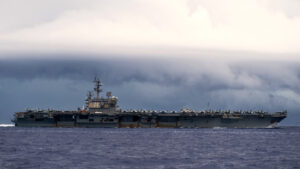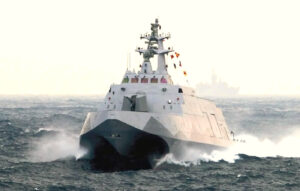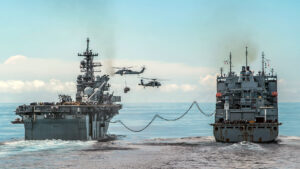Aircraft carriers and restricted areas: The USA and China are flexing their "muscles" in the tug-of-war over the island of Taiwan.
Following the now interrupted Chinese military exercises in the Taiwan Strait and around the island state (with live ammunition - something that has been pointed out time and again), the American side is now also asserting that it does not want to do without its usual freedom of navigation operations (FONOPS) there. At the beginning of August, the Pentagon confirmed that the U.S. Navy will continue to sail through disputed international waters in the coming weeks to "protect freedom of navigation". However, the overall situation is currently more heated than ever due to the not uncontroversial visit to Taiwan by the Democratic leader in the US Congress, Nancy Pelosi.

American forces
Flanked by the amphibious assault carrier USS Tripoli, the carrier group of the USS Ronald Reagan is located in the sea area between Japan and Taiwan, while the Expeditionary Strike Group of the USS America is said to be located at the Japanese base of Sasebo itself.

Innovation in Taiwan's navy
Taiwan's navy is capitalising on the advantage of innovation on a small scale and is currently continuing to test its new corvette "Tou Chiang" based on a catamaran-like twin-hull platform. Somewhat small, but fast, manoeuvrable and compact. With the ingenuity shown time and again by Taiwanese shipbuilders, the Rupf will pack everything that is needed in coastal waters and what the exposed location of the island requires.
Chinese approach
For its part, China has the two available carriers "Liaoning" and "Shandong" in the area, but these have not yet been involved in the exercises, although they will be in the next stage of the escalation. It should be noted that China has positioned its exercise areas in international waters in such a way that they - temporarily declared as restricted areas - significantly restrict, if not block, free access to the island of Taiwan from the east. These would be the routes of any American-led support for the democratically governed island in the event of an emergency, and China wants to prevent this at all costs. And as far as the U.S. Navy's FONOPS are concerned, the boundaries of the Chinese restricted areas at the entrance and exit of the Taiwan Strait are drawn in such a way that only the territorial waters remain free - if at all. Now this does not mean that it is not allowed to enter these areas under any circumstances, but munitions could be deployed there without warning, which is of course legally controversial without a declared state of war. But who cares if there really is a war? A new tactical move to effectively disrupt the closures would also be the use of fishing vessels in larger containers - as demonstrated off Ireland at the beginning of the year. However, the advantage is clearly on the Chinese side with its almost inexhaustible stocks of militia-like organised state fishing squadrons.
International waters

China repeats like a mantra that it does not consider the approximately 100-kilometre-wide Taiwan Strait to be an international waterway and that it should be regarded as Chinese territorial waters. However, according to the United Nations Convention on the Law of the Sea of December 1982, 55 kilometres of international waters remain between the territories. China has ratified UNCLOS - Taiwan and the USA have not. The US-Chinese dialogue channels at government and naval level, which are said to have frozen abruptly after Pelosi's visit, are also currently unable to help defuse the situation. In the shadow of the Russian war in Ukraine and the associated shifts in the strategic assessment of Russia's military strength, there is scope for momentous overestimates and underestimates.
Simulation of destruction
Critics of this situation are already warning that the mere possibility of a military confrontation between the USA and China has now become a probability. In order to assess the dimensions of such a confrontation, the Asia department of the London-based think tank International Institute of Strategic Studies (IISS) calculated a four-week scenario (without the use of nuclear weapons) and came to the conclusion that this could be the most costly confrontation for the USA since the Second World War. The Wall Street Journal reported on this. In the expanded China-Japan-Guam triangle, the USA would lose half of its floating and airborne forces and China a corresponding amount - with no significant combat assets left on the Chinese side. This would of course significantly shift the balance of power globally and, above all, regionally - completely new players would appear on the scene! So much for the material - lost lives were not calculated, or rather: not named. So why all the mainland Chinese theatre about Taiwan at the present time, when the navy has not yet reached its full potential? A milquetoast calculation with the highest stakes! And it will remain so for some time to come.










